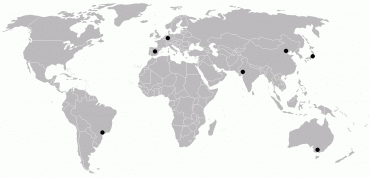16.11.2012 – Issue 5 - Global Observatory – Sauter Florian – Essays
Global Style
by Florian Sauter
It is no secret that from an operative standpoint the internet has proven its worth: as a tool that enables the easy and cheap transfer of data and communication, it has revolutionized architectural working procedures and allowed numerous offices to build globally on an hitherto unknown, at least quantitative, scale. Besides, in recent years several blog-based architectural sites have arisen, which with their additive structures have demonstrated perfect suitability to track down the ever new. Both in terms of their pace of collecting information and their array of outlook they make the classical project-oriented and printed periodical look outdated. Gathering dozens of yet unheard of voices, these sites allow for the first time in history architects from all parts of the world to be present in the contemporary architectural discourse, herewith shifting the focus from a former elite and American-European dominated debate towards new centers of theoretical and practical activity – particularly the American South (Chile, Brazil, Mexico) and Asia (China, Japan, India), but also the Middle East, Australia, Africa and Eastern Europe (Russia) have thus become more accessible. However, if one expects a vast variety of design approaches to become visible, he or she will soon be disappointed. Neglecting a certain proliferation of architectural absurdities that seem to be an inherent part of our society of spectacle and its call for attention, it appears that this easier way of exchanging ideas and visual stratagems is in fact the basis of a fundamental leveling - in short: a new, but less dogmatic “Internationalism“ seems on the rise. Characterized is this “Global Style“ not so much by a distinct repertoire of certain formal and conceptual parameters – for sure no outspoken “5 points” – but rather by some tentative trends that the architect from Beijing seems to obey just as much as the one from Warsaw or Buenos Aires: minimal cubatures and restrained details, fluid forms and parametric designs, heavy tectonics and brute finishes, refined textures and experimental materials, sustainable underpinnings and iconic features – these may be some of the common denominators engrossing the agenda. The consequence is more often than not a ridiculous sameness, a rather frightening de-contextualization and homogeneity, which makes apparent that the style’s present credo is constrained into the trajectory of a globally accepted taste – the production of a fabricated, aestheticized imagery – rather than the exploitation of the local heritage and culture with its tangible expressions of the existential grounds and primordial meanings of human existence. The selected buildings and projects aim to indicate pathways to a more polychromatic future, one where the current Zeitgeist can be accepted without relinquishing a sense of personal/vernacular authenticity.
Download article as PDF


